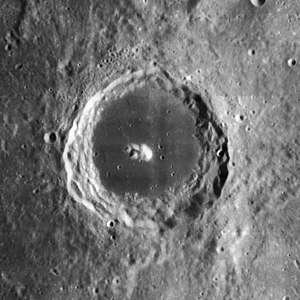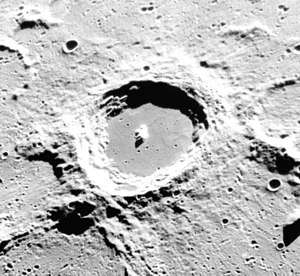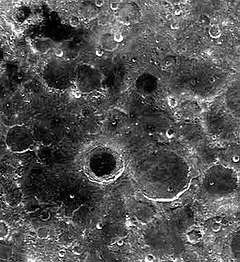Jenner (crater)
Jenner is a lunar crater that is located within the Mare Australe. It lies just past the southeastern limb, on the far side of the Moon, and can be viewed from the Earth during periods of favorable libration and lighting. Nearly attached to the eastern outer rim of Jenner is the larger, flooded crater Lamb.
 Lunar Orbiter 4 image | |
| Coordinates | 42.01°S 95.98°E |
|---|---|
| Diameter | 74 km |
| Depth | Unknown |
| Colongitude | 265° at sunrise |
| Eponym | Edward Jenner |


This is a nearly circular crater with a sharp but somewhat irregular edge that has not been significantly eroded. There are some terraces, particularly along the southwestern inner walls, and some slumping along the southeastern rim. The interior floor has been flooded by basaltic lava, leaving a dark, level interior. There are no breaks in the exterior rim where the lava could have entered the crater, so it was presumably flooded from below. The floor is marked only by a few tiny craterlets. Surrounding Jenner is a rampart of ejecta that extends for over a half crater diameter in some directions.

Satellite craters
By convention these features are identified on lunar maps by placing the letter on the side of the crater midpoint that is closest to Jenner.
| Jenner | Coordinates | Diameter, km |
|---|---|---|
| M | 45.85°S 95.69°E | 11 |
| X | 37.32°S 93.83°E | 12 |
| Y | 38.50°S 94.77°E | 31 |
External links
- Jenner Crater: Mare Flooded Floor, Lunar Reconnaissance Orbiter Camera (LROC), Posted by Drew Enns on June 21, 2011 09:00 UTC.
References
- Andersson, L. E.; Whitaker, E. A. (1982). NASA Catalogue of Lunar Nomenclature (PDF). NASA RP-1097. Archived from the original on 2014-10-06.CS1 maint: ref=harv (link) CS1 maint: BOT: original-url status unknown (link)
- Blue, Jennifer (July 25, 2007). "Gazetteer of Planetary Nomenclature". USGS. Retrieved 2015-01-25.CS1 maint: ref=harv (link)
- Bussey, B.; Spudis, P. (2004). The Clementine Atlas of the Moon. New York: Cambridge University Press. ISBN 978-0-521-81528-4.CS1 maint: ref=harv (link)
- Cocks, Elijah E.; Cocks, Josiah C. (1995). Who's Who on the Moon: A Biographical Dictionary of Lunar Nomenclature. Tudor Publishers. ISBN 978-0-936389-27-1.CS1 maint: ref=harv (link)
- McDowell, Jonathan (July 15, 2007). "Lunar Nomenclature". Jonathan's Space Report. Retrieved 2007-10-24.CS1 maint: ref=harv (link)
- Menzel, D. H.; Minnaert, M.; Levin, B.; Dollfus, A.; Bell, B. (1971). "Report on Lunar Nomenclature by the Working Group of Commission 17 of the IAU". Space Science Reviews. 12 (2): 136–186. Bibcode:1971SSRv...12..136M. doi:10.1007/BF00171763.CS1 maint: ref=harv (link)
- Moore, Patrick (2001). On the Moon. Sterling Publishing Co. ISBN 978-0-304-35469-6.CS1 maint: ref=harv (link)
- Price, Fred W. (1988). The Moon Observer's Handbook. Cambridge University Press. ISBN 978-0-521-33500-3.CS1 maint: ref=harv (link)
- Rükl, Antonín (1990). Atlas of the Moon. Kalmbach Books. ISBN 978-0-913135-17-4.CS1 maint: ref=harv (link)
- Webb, Rev. T. W. (1962). Celestial Objects for Common Telescopes (6th revised ed.). Dover. ISBN 978-0-486-20917-3.CS1 maint: ref=harv (link)
- Whitaker, Ewen A. (2003). Mapping and Naming the Moon. Cambridge University Press. ISBN 978-0-521-54414-6.CS1 maint: ref=harv (link)
- Wlasuk, Peter T. (2000). Observing the Moon. Springer Science & Business Media. ISBN 978-1-852-33193-1.